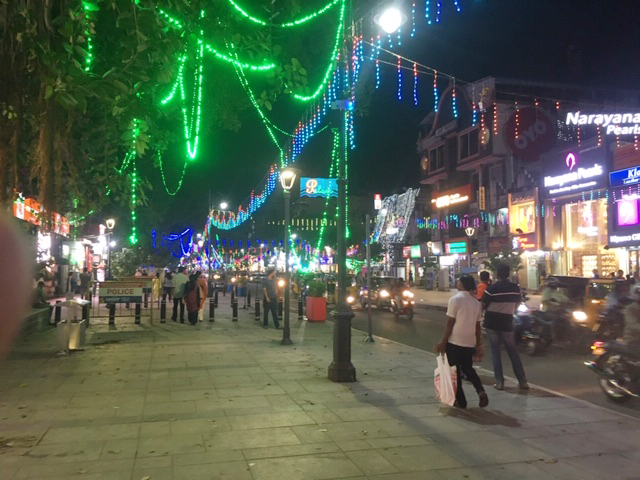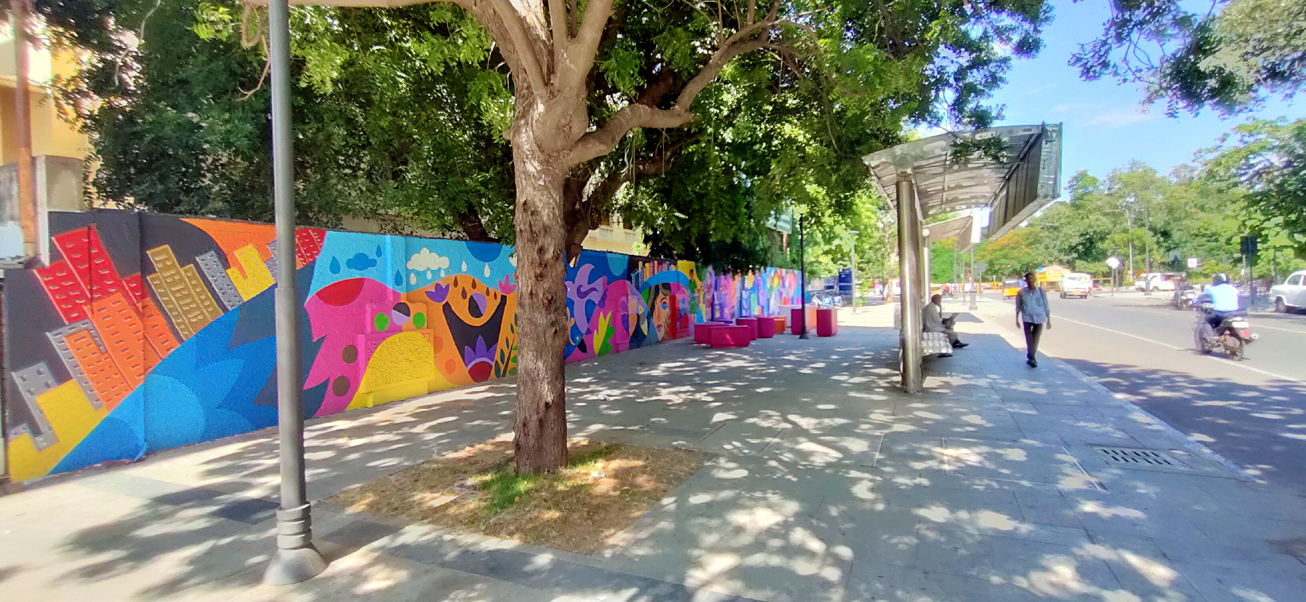Registered with the Registrar of Newspapers for India under R.N.I 53640/91
Vol. XXIX No. 16, December 1-15, 2019
Pedestrian plazas good, but not enough
by A Special Correspondent
The T. Nagar Pedestrian Plaza has just been inaugurated under the aegis of the Smart City project. The project kicked off in mid-2018 and, at an outlay of Rs. 33.8 crores, it has been completed in eighteen months, except for the planned multi-level car park. Similar Pedestrian Plazas are to be constructed in Velachery, Anna Nagar and Tondiarpet.
T. Nagar’s Plaza stretches from the Thanikachalam Road-Theyagaroya Road intersection to Panagal Park junction. The original vehicular road has been narrowed down to accommodate just a one-way traffic towards Panagal Park, allowing cars to park on the left. The space thus released has broadened the walking paths on either side of the one-way road. Pedestrian walkways are smoothly paved; they’re equipped with benches and bollards to prevent two-wheeler invasion, as well as ramps for easy movement of pedestrians from road to pavement and vice versa.
When I visited the Plaza, shops on either side of the road seemed to be celebrating the new shopper-friendly atmosphere in full swing. They have undergone a major make-over to take advantage of the substantial increase in footfall in the Plaza as a result of the new congenial ambience. Pondy Bazaar is dazzling, especially in the evenings, flaunting its claim to be the best open-air mall in this part of the country.
However, the dustbins placed at intervals are too small for the volume of garbage that a busy evening in the Plaza generates. Many of them are overflowing. Larger bins and continuous clearing are necessary. A dedicated cycle track with coloured tiles, that was part of the proposed design, could not be identified on the crowded Saturday evening of my visit.
A disappointing outcome is the increase in noise and pollution levels from the continuous traffic that moves through the Plaza. If the new Plaza seeks to provide a fine experience for shoppers, it is perhaps necessary to remove the provision for motorised traffic altogether on this short stretch. Shoppers, after parking their vehicles, should be able to walk about in the Plaza free from traffic and its pollution. Once vehicles are allowed, two-wheelers tend to take the law into their hands and it is impractical to keep them under watch all the time. We witnessed a harassed cop trying to control the criss-crossing of motorcycles defying his presence and invading the new walkways. We understand that there is a plan to hold periodic street shows and music but these may be drowned out by the noise of the ceaseless traffic that is presently permitted. If traffic is blocked, a narrow strip is all that is needed in the middle for a couple of electric mini-buses to ply up and down, stopping for hop-ons and hop-offs. The removal of noise, smoke and dust would bring about a world of improvement to the open-air mall atmosphere. We do not know if the traffic is a temporary feature or specifically allowed for in the design. If it is the latter, it is a serious dampener to the objective of creating a relaxed, pollution-free ambience.
The Smart City concept has brought other pedestrian woes to the forefront as well. All these years, pedestrians have been ignored in road design. Government engineers, even today, are trained to think of making roads only for motorised vehicles, with pedestrians getting an apology of a walkway and that, only if anything remains. Chennai may be among the most “walked on” cities in the country. The limited space protected for pedestrian use turns away thousands of people from walking to two-wheelers or autos. In our weather, quite a large part of our outings could be walk-trips, if good walking paths are made available. There could be a substantial reduction in the usage of motorised transport, saving oil, lessening congestion and reducing pollution and accidents.
The ripple effect of the Smart City programme is being felt not only in the new pavements on 23 roads in T. Nagar in and around the Plaza, but also in other areas of the city (N.S.C. Bose Road, Pantheon Road and Police Commissioner’s Office Road) that are outside the Plaza. But this piecemeal approach will not be enough to make Chennai a city for walkers. A master plan for creating non-motorised mobility throughout the city is badly needed. The creation of well-designed and protected pathways would necessarily lead to streamlining traffic flow, cleaner walls by dint of eradicating wall posters, graffiti, banners and hoardings, and cleaner pathways by ensuring timely garbage removal. A single point agenda of pedestrianisation of streets within, say, 18 or 20 months could make our city far more liveable. Establishing Plazas under the Smart City Plan is meant to demonstrate a model and not to be the complete solution by itself. The Government has at its disposal the expertise of Chennai Smart City Ltd, the permanent special institutional vehicle created for the Smart City concept, which it could use to implement a master plan to modernise walking paths and, generally, enlarge the scope for non-motorised mobility.
Public facilities are most often not maintained post-project due to the lack of sufficient funds or staff to maintain the space from illicit users. The master plan must ensure enough funds and organisational mechanisms for upkeep and maintenance.
A government is “real” when people see and experience the tangible outcomes of its actions such as good roads, clean water, garbage-free surroundings etc. The creation of walkways in the city has the potential to be one such tangible product of good governance. We hope the Smart City spirit will not fade away after producing showpieces standing as islands in a sea of continued neglect and deterioration.
 Two views of the new pedestrian plaza at T. Nagar. Will it last?
Two views of the new pedestrian plaza at T. Nagar. Will it last?


